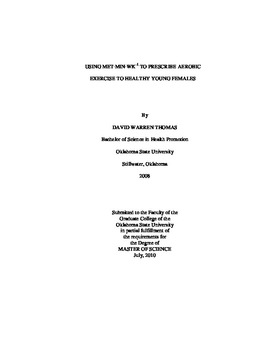| dc.contributor.author | Thomas, David Warren | |
| dc.date.accessioned | 2014-04-16T03:11:56Z | |
| dc.date.available | 2014-04-16T03:11:56Z | |
| dc.date.issued | 2010-07-01 | |
| dc.identifier.uri | https://hdl.handle.net/11244/9796 | |
| dc.description.abstract | The purpose of this study was to analyze the changes in health-related data following two different exercise prescriptions that varied in intensity and frequency, however, remained similar in total MET?min?wk-1 volume. Ten healthy college-aged female volunteers were used as subjects. The subjects were divided into two groups, moderate-intensity training group and moderate/vigorous-intensity training group. Both training groups began their programs by accumulating approximately 500 MET?min?wk-1 and further increased their training by roughly 75 MET?min?wk-1 after every two weeks for a total of eight training weeks. The moderate-only training group exercised on five days per calendar week while the moderate/vigorous-training groups exercised on only four days per calendar week. Both groups accumulated 30 minutes of training stimulus per day. The moderate-intensity group exercised at a constant moderate intensity (3.0-6.0 METs) for the entire 30 minutes whereas the moderate/vigorous-intensity training group achieved 10 minutes of exercise at a vigorous intensity (> 6.0 METs) followed immediately by 20 minutes of exercise at a moderate intensity (3.0-6.0 METs). Both groups completed identical five minute warm-up and cool-down periods at a light intensity (< 3.0 METs) before and after their exercise training stimulus. Each of the two training programs was designed in to reflect current American College of Sports Medicine physical activity guidelines for healthy adults. Pre-training and post-training data were collected for seven different health-related variables. The variables were maximal oxygen consumption, resting heart rate, resting systolic blood pressure, resting diastolic blood pressure, body weight, body mass index, and percent body fat. Findings and Conclusions: The results showed that within-group resting systolic blood pressure was the only significantly different variable of the seven (p = 0.24). Trend data, however, did also exist for improved maximal aerobic capacity and decreased resting diastolic blood pressure. In general, both groups progressed in a similar manner over the course of the eight week training period. | |
| dc.format | application/pdf | |
| dc.language | en_US | |
| dc.publisher | Oklahoma State University | |
| dc.rights | Copyright is held by the author who has granted the Oklahoma State University Library the non-exclusive right to share this material in its institutional repository. Contact Digital Library Services at lib-dls@okstate.edu or 405-744-9161 for the permission policy on the use, reproduction or distribution of this material. | |
| dc.title | Using Met?Min?Wk?? to Prescribe Aerobic Exercise to Healthy Young Females | |
| dc.type | text | |
| osu.filename | Thomas_okstate_0664M_11067.pdf | |
| osu.college | Education | |
| osu.accesstype | Open Access | |
| dc.description.department | School of Teaching and Curriculum Leadership | |
| dc.type.genre | Thesis | |
| dc.subject.keywords | aerobic | |
| dc.subject.keywords | mets | |
| dc.subject.keywords | vo2max | |
